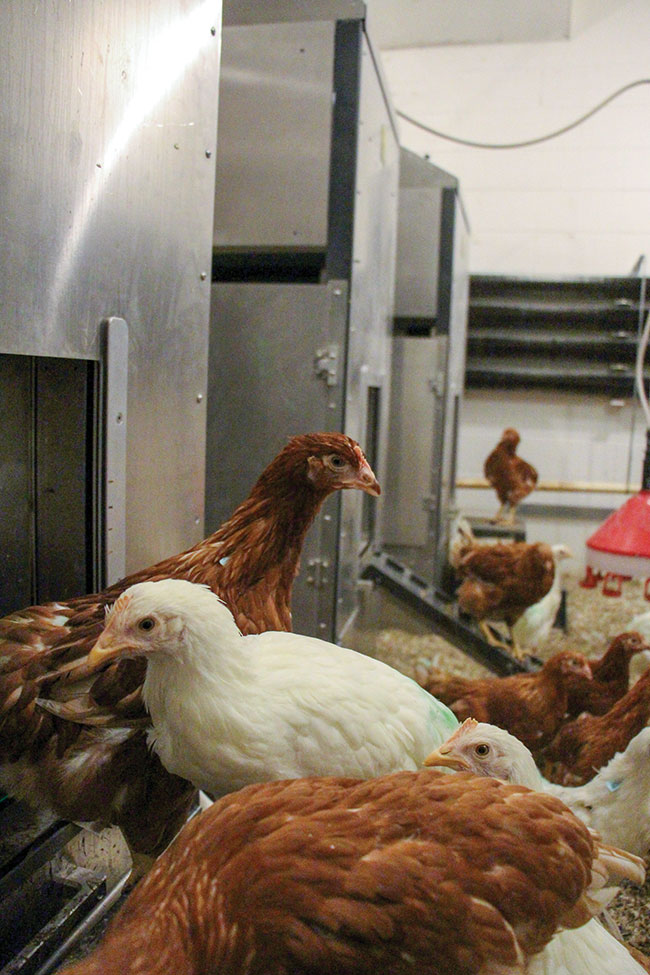
Pullets: Unlocking the potential of precision feeding
By Jane Robinson
Features Nutrition and FeedNew research out of the University of Alberta sheds light on pullet rearing strategies for optimal egg production.
 Layer pullets interacting with multi-feed precision feeding stations.
PHOTO CREDIT: Jo Ann Chew
Layer pullets interacting with multi-feed precision feeding stations.
PHOTO CREDIT: Jo Ann Chew Research is just scratching the surface to understand how nutrition can bring pullets into lay in optimum body condition, according to Dr. Martin Zuidhof. “What’s really missing in the literature is information on how pullet rearing strategies impact long-term egg production,” says Zuidhof, who’s in charge of poultry systems modeling and precision feeding in the Agricultural, Food and Nutritional Science Department at the University of Alberta.
The multi-feed precision feeding system he created is proving to be an invaluable research tool for evaluating nutritional strategies during pullet rearing. “One of the advantages to using precision feeding stations is the efficiency for studying various diets, and the ability to apply treatments to individual birds and gather data on them in a free-run environment,” he says. “We wanted to look specifically at the impact of energy and protein during rearing.”
Zuidhof’s graduate student Jo Ann Chew is working on the underlying mechanisms that bring pullets into lay for her PhD. “My project is looking to determine pullet rearing optimization strategies – what we feed a growing bird and how that impacts their lifelong health and productivity,” says Chew.
The project was split into two parts looking at dietary energy and protein/amino acid levels separately. Another one of Zuidhof’s PhD students, Thiago Noetzold, was also involved in the dietary energy study.
Evaluating energy
The first trial focused on how different levels of energy affected egg production and ran from April 2021 until December 2022. Three dietary energy levels were compared – 2,800 kilocalories per kilogram (industry standard), a lower level at 2,600 kilocalories and a higher level at 3,000 kilocalories. Diets were fed to pullets in multi-feed precision feeding stations on an unrestricted or restricted basis.
“Each bird was fitted with a radio frequency identification (RFID) tag to align with the diet and feeding frequency assigned,” says Chew. “When the birds enter the feeding station, the RFID tag is read, and the appropriate diet is dispensed.”
Birds assigned unrestricted feeding received a meal any time they enter a feeding station, while birds on restricted access feeding received a meal based on a frequency that kept them on the lower end of the breeder recommended body weight trajectory for pullet growth. “We looked at a bit of feed restriction in this study to see if we could save a little on feed and still come up with the body condition at lay that would support a productive laying cycle,” says Zuidhof.
The study also included a “choice” group where birds had access to all three energy level diets when they entered the feeding station. For comparison, the project also included a conventional feeding system with birds in treatment pens – one for each energy level diet. The choice group was omitted in the conventional feeding study.
All birds were monitored through rearing for body fat, body weight, feed intake, age at first lay, egg production and egg quality. They were monitored throughout the lay period, although the feeding treatments ended when they came into lay; all birds received the same diet during the egg-laying phase.
Full feed access is best
While the results are still preliminary, there are a few clear findings when comparing energy levels and feed access options in pullet rearing.

University of Alberta graduate student Jo Ann Chew is working on the underlying mechanisms that bring pullets into lay for her PhD.
Layer pullets with unrestricted access to feed came into lay earlier than birds with restricted access to feed. There was no difference between the three energy levels fed with the precision feeding system for the age at first lay. Birds fed the standard level of energy (2,800 kilocalories per kilogram) showed the most promising results if fed unrestricted. Birds fed the standard diet with restricted access performed lower.
“If you think about the application to industry, the birds fed the standard energy diet were most promising when feed intake was not restricted in any way,” says Chew. “If access to feed is restricted, as we simulated with precision feeding, birds will perform at a lower level,” says Chew.
The bottom line. “The industry has it right for layer pullets when it comes to energy level in the diet and providing pullets with unrestricted access to feed,” says Zuidhof.
Optimizing protein
The protein portion of the study started in May 2023 and is taking a slightly different approach – looking to find the level of protein pullets need to obtain their maximum rate of gain prior to sexual maturation. The precision feeding stations are being used to assign different diets but there is no feed restriction component.
“We are comparing brown-feathered and white-feathered strains to see if optimum protein levels during rearing are strain-dependent,” says Chew. “We’ll also look at how differences in body composition influence the onset of lay between the brown- and white-feathered birds.”
Results of this study are expected in early 2024.
A new era in pullet feeding
The question now is whether precision feeding will become the new normal in layer pullet rearing as it has already shown promise in broiler breeders. Not just yet, says Zuidhof.

Dr. Martin Zuidhof oversees poultry systems modeling and precision feeding in the Agricultural, Food and Nutritional Science Department at the University of Alberta.
The precision feeding system serves up a solid research role but there are no clear benefits for the layer industry at this time. “There is still so much we need to know about what individual layer pullets need from a nutrition point of view,” he says. “We need to figure that out before precision feeding would make sense for commercial layers.”
Considering that this research showed no advantage to restricting feed when rearing pullets, compared to the conventional feeding system producers are using, there is no need for precision feeding in a commercial setting right now.
But as a research tool, it’s critical to figure out how to feed individual birds and adjust their diets. Zuidhof knows there will be benefits for the system in layers, just maybe not in his lifetime.
“When we feed an animal what it needs, when it needs it, you minimize feed waste so there are environmental as well as performance and economic benefits to precision feeding,” says Zuidhof. “We’re just not ready to implement it yet with layers.”
Print this page